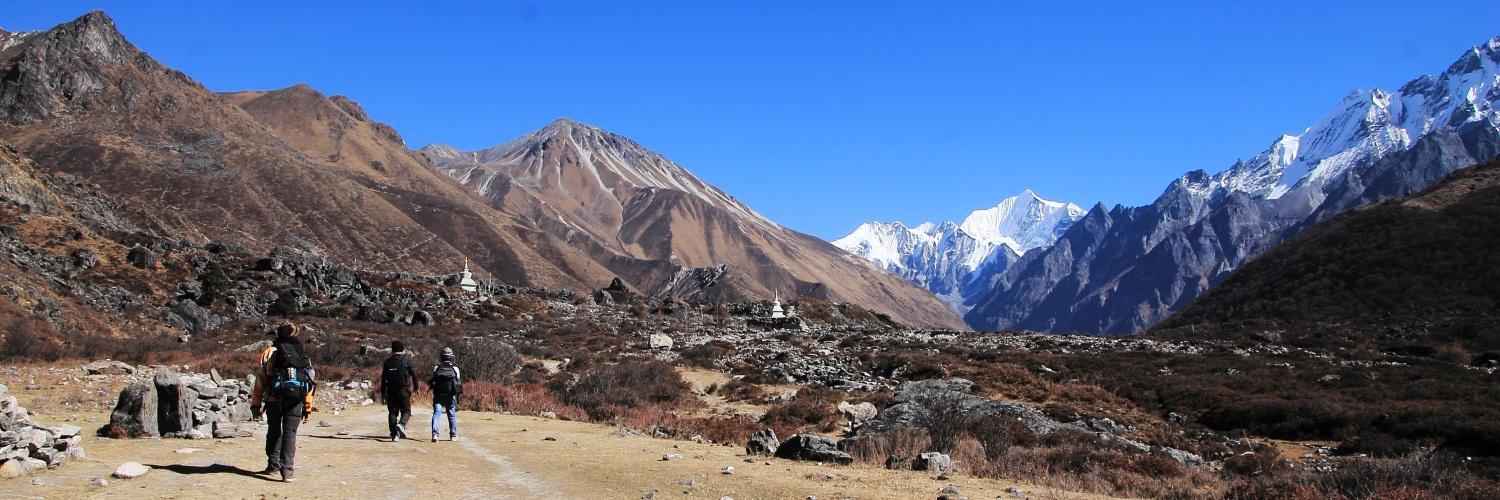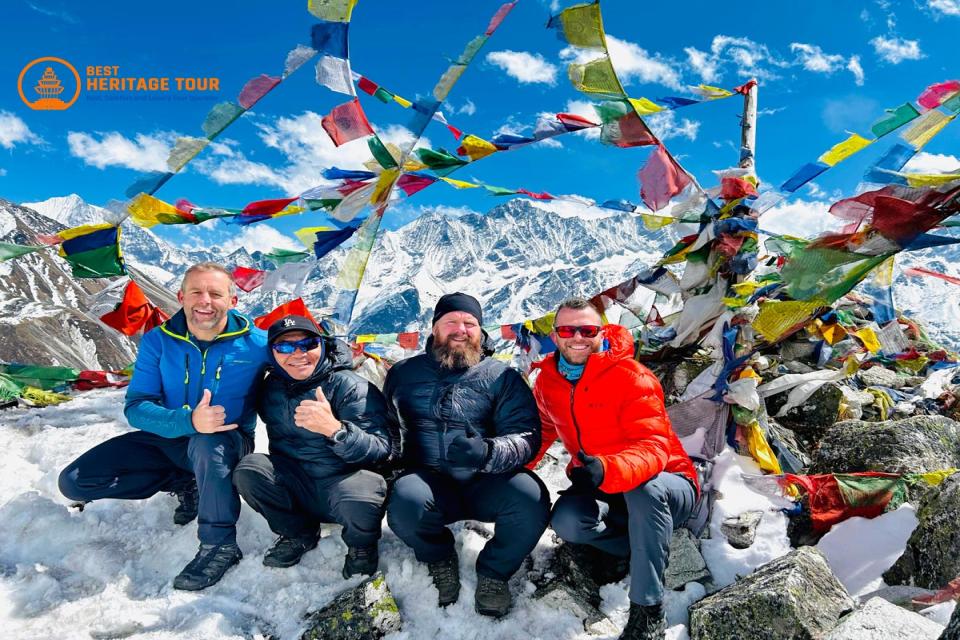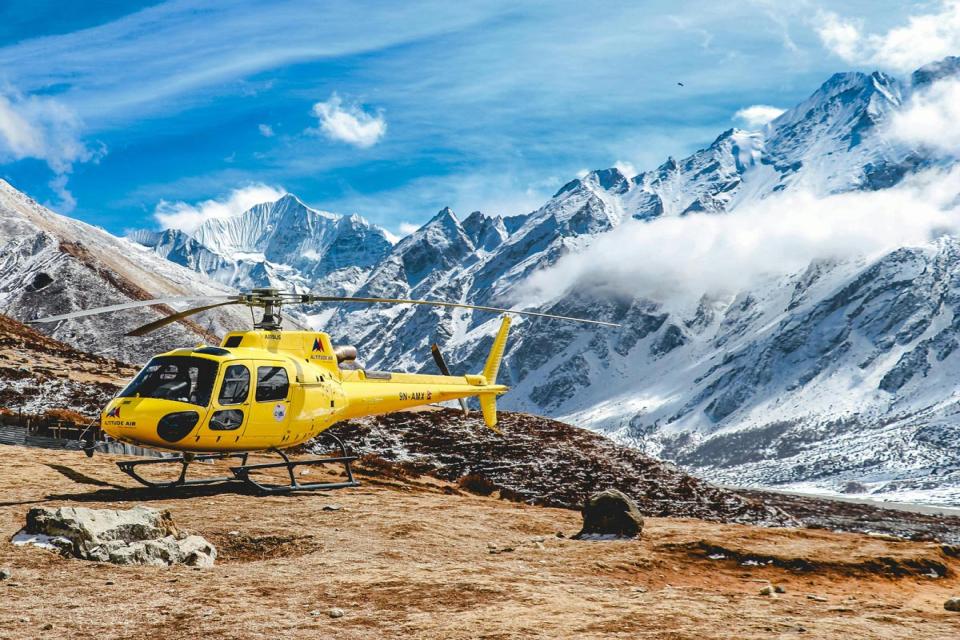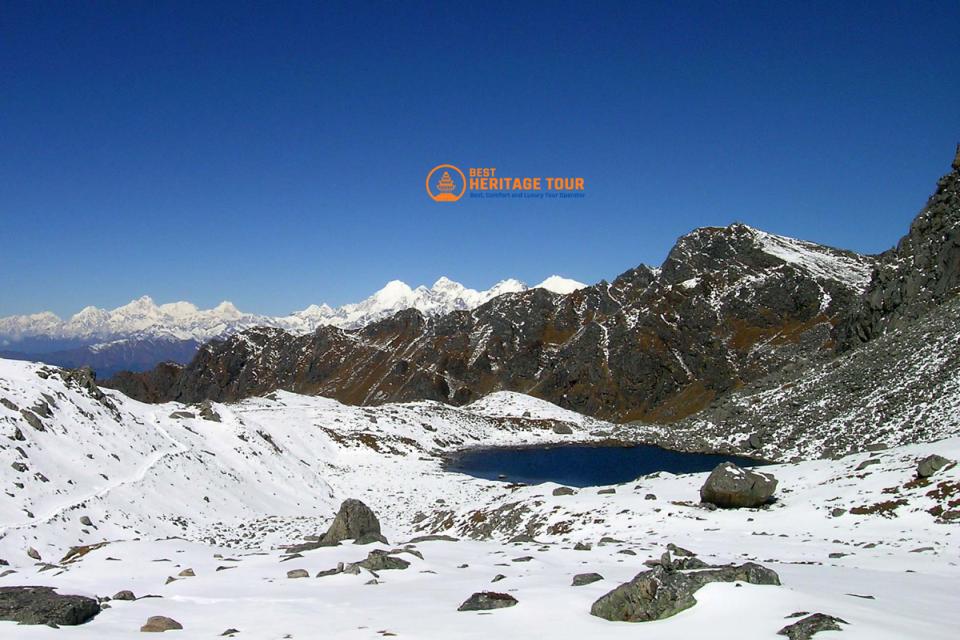Nestled just north of Kathmandu, the Langtang Valley Trek is one of Nepal's most accessible and rewarding trekking adventures. With dramatic Himalayan views, rich Tamang culture, and serene alpine landscapes, this trek is an underrated gem among Nepal’s trekking routes.
But is September the right time to explore this majestic valley? The answer is a resounding yes, and in this guide, we'll show you why. From weather patterns to gear packing, cost breakdown, and itinerary planning, here’s everything you need to know about the Langtang Valley Trek in September 2025/2026.
Why Choose Langtang Valley Trek in September?
Langtang Valley Trek is one of Nepal’s most spectacular and accessible trekking routes, offering breathtaking mountain views, vibrant Tamang culture, and an immersive journey through Langtang National Park. While the trek is doable throughout the year, September stands out as one of the best months to experience the true magic of Langtang, especially right after the summer monsoon rains.
-
September: The Gateway to Autumn in the Himalayas
September kicks off Nepal’s post-monsoon trekking season with clearing skies and breathtaking views of Langtang’s snow-capped peaks like Langtang Lirung (7,227m), Gangchempo (6,387m), and Dorje Lakpa (6,966m). The valley bursts with lush greenery and wildflowers, making it a top choice for nature lovers and photographers.
-
Fewer Crowds, Authentic Cultural Encounters
Compared to the busy October peak, September offers quieter Langtang trails, allowing trekkers peaceful hikes and genuine interactions with Tamang locals. You’ll also find more availability in teahouses, enhancing your trekking comfort.
-
Ideal for Nature Lovers and Budget Trekkers
Post-monsoon freshness rejuvenates forests, waterfalls, and wildlife in September. Accommodation and transport costs remain lower than peak season, making Langtang Valley Trek in September 2025/2026 perfect for budget-conscious adventurers seeking vibrant landscapes.
How Does September Compare to Other Trekking Months?
|
Month |
Weather & Conditions |
Crowds |
Highlights |
|---|---|---|---|
|
August |
Heavy rain, slippery trails, landslide risk |
Very low |
Monsoon green, but risky |
|
September |
Clearing skies, moderate rainfall, lush greenery |
Low to moderate |
Fresh post-monsoon scenery, fewer leeches |
|
October |
Stable, dry, clear mountain views |
High |
Best weather but crowded & costly |
|
November |
Cold, dry, brownish landscapes |
Moderate |
Crisp air and excellent visibility |
If you want to avoid the October crowds yet enjoy stunning scenery and pleasant weather, September offers the perfect balance for trekking Langtang Valley.
Weather and Trail Conditions in Langtang during September
September in Langtang marks the welcome transition from the monsoon-soaked summer to the crisp, clear days of autumn. While early September can still see lingering rains, the weather generally improves as the month progresses, offering increasingly stable conditions for trekkers. Understanding what to expect from the climate and trail in this month is essential for preparation and safety.
-
Temperature and Climate: Daytime temperatures range from 10°C to 20°C (50°F to 68°F) at lower altitudes and 5°C to 15°C (41°F to 59°F) near Kyanjin Gompa. Nights get colder, often near freezing by month-end. Humidity fades, giving way to fresh, clear air and excellent mountain visibility.
-
Rainfall and Trail Conditions: Early September may still bring light rain and muddy trails, especially in forested sections like Bamboo and Lama Hotel, with occasional leeches. Trails dry out significantly by mid-month, making trekking safer with fewer landslide risks.
-
Visibility and Scenery: Mid to late September offers stunning panoramic views of Langtang peaks, lush green valleys, and roaring waterfalls, perfect for nature photography around Langtang Khola, Kyanjin Ri, and Tserko Ri.
-
Wildlife and Natural Beauty: September is great for spotting wildlife like langurs, Himalayan monals, musk deer, and occasionally red pandas in Langtang National Park. The vibrant flora and mossy forests add to the trek’s natural charm.
Langtang Valley Trek Highlights in September
September is one of the best months to trek Langtang Valley, offering a perfect blend of post-monsoon freshness, fewer crowds, and spectacular mountain views.
-
Lush Green Landscapes: After the monsoon rains, forests of rhododendron, oak, and bamboo are vibrant and alive, with blooming wildflowers and flowing waterfalls.
-
Clear Mountain Views: By mid-September, enjoy stunning panoramas of Langtang Lirung (7,227m), Dorje Lakpa (6,966m), and Gangchempo (6,387m) from viewpoints like Tserko Ri and Kyanjin Ri.
-
Less Crowded Trails: September sees fewer trekkers than peak months, providing peaceful trekking and authentic cultural experiences with the Tamang and Tibetan communities.
-
Cultural Richness: Experience local harvest festivals, visit monasteries in Kyanjin Gompa, and taste traditional Himalayan foods like yak cheese.
-
Wildlife Spotting: Langtang National Park’s abundant wildlife, including red pandas, Himalayan thar, and various birds, are more active in September’s cool climate.
For budget-friendly trekking with lush scenery and great weather, Langtang Valley Trek in September 2025/2026 is an excellent choice.
Langtang Valley Trek Itinerary for September 2025/2026
Here’s a sample 8-day Langtang Valley Trek itinerary including transportation from Kathmandu:
Day 1: Drive from Kathmandu to Syabrubesi (1,460m) – 7 to 8 hours
Day 2: Trek to Lama Hotel (2,470m) – 6 hours
Day 3: Trek to Langtang Village (3,430m) – 6 hours
Day 4: Trek to Kyanjin Gompa (3,870m) – 4 hours
Day 5: Acclimatization day: Hike to Tserko Ri (4,984m)
Day 6: Return trek to Lama Hotel
Day 7: Trek to Syabrubesi
Day 8: Drive back to Kathmandu
Optional add-ons:
- Hike to Langshisa Kharka for expansive views of glaciers
- Explore Yala Peak Base Camp if you’re looking for adventure
Langtang Valley Trek Difficulty and Trail Condition in September
The Langtang Valley Trek is moderate in difficulty, suitable for fit beginners and experienced trekkers. September brings some unique trail challenges due to lingering monsoon effects, so preparation is key.
Overall Difficulty
- Max altitude: Optional Tserko Ri hike (5,000m)
- Main high point: Kyanjin Gompa (3,870m)
- Daily trekking: 5–7 hours
- Elevation gain: Moderate but steady from Syabrubesi to Kyanjin
- Technical skills: None, well-marked trails with gradual ascents
Most trekkers in good shape find the trek manageable if they pace themselves and acclimatize well.
September-Specific Challenges
- Trail: Muddy and slippery in lower forest sections (Syabrubesi to Lama Hotel)
- Leeches: Present early in the month
- Landslides: Possible temporary blockages or diversions
- Rain: Short, occasional afternoon showers
Conditions improve mid to late September, but flexibility and proper gear are important.
Physical Preparation
- Do cardio and strength training 4–6 weeks before
- Practice day hikes with a loaded backpack
- Understand altitude effects if new to high elevations
Note: Suitable for Beginners? Yes! Beginners with good fitness, waterproof gear, and altitude awareness can enjoy the trek. Adding buffer days and
Permits and Entry Requirements for Langtang Trek in 2025/2026
Before you set off on your Langtang Valley adventure, it’s important to understand the official permits and regulations that apply to all trekkers in the region. The Langtang Valley Trek falls under a protected area, meaning you’ll need permits issued either in Kathmandu or at the trailhead before entering Langtang National Park.
Required Permits for Langtang Valley Trek (2025/2026)
1. Langtang National Park Entry Permit
- Purpose: Grants access to Langtang National Park, which protects the region's flora, fauna, and cultural heritage.
- Fee:
- NPR 3,000 per person (approx. USD 23) for foreigners
- NPR 1,500 for SAARC nationals
- Free for Nepali citizens (with ID)
- Where to get it:
- Nepal Tourism Board office in Kathmandu
- Entry checkpoint at Dhunche or Syabrubesi
2. TIMS Card (Trekkers’ Information Management System)
- Purpose: Tracks trekkers for safety, helps in rescue operations, and contributes to tourism development.
- Fee:
- NPR 2,000 per person for individual trekkers
- NPR 1,000 per person if you're trekking with a registered guide or agency
- Where to get it:
- TAAN Office (Trekking Agencies’ Association of Nepal) in Kathmandu or Pokhara
- Not always enforced in Langtang, but strongly recommended
Note: As of 2023–2024, there were discussions about making TIMS compulsory even for guided treks in Langtang. By 2025/2026, it’s safest to assume you’ll need one.
Where and How to Obtain Trekking Permits
Most trekkers obtain both permits in Kathmandu before departure to avoid delays on the trail. Here’s how:
- Nepal Tourism Board (NTB)
- Location: Bhrikutimandap, Kathmandu
- Open: 10 AM to 5 PM (Sunday–Friday)
- Bring: Your passport and two passport-sized photos
- Via trekking agency: If you’re booking through a local trekking agency or guide, they’ll arrange all necessary permits for you, often included in the Langtang Trek package cost.
What to Carry with Your Permits
- Always carry physical copies of your TIMS and Langtang National Park permits while trekking, you will be asked to show them at multiple checkpoints.
- Keep digital backups on your phone just in case.
- If you're caught without a valid permit, you could face fines or being turned back at checkpoints.
Quick Permit Checklist for Langtang Valley Trek:
|
Permit Type |
Cost (USD) |
Where to Get |
Required? |
|---|---|---|---|
|
Langtang National Park Permit |
~$23 |
NTB or entry checkpoints |
Yes |
|
TIMS Card |
~$15–20 |
TAAN Office or via agency |
Yes |
|
Special Permits (Restricted) |
No |
Not required for Langtang |
No |
Rules and Trekking Guidelines (2025/2026 Updates)
- Solo trekking is still allowed in Langtang (as of 2024), but check for 2025 updates, as regulations can change.
- Drones require special permits, especially within Langtang National Park.
- Respect local customs and conservation rules, especially when visiting monasteries or natural sacred sites.
What to Pack for the Langtang Valley Trek in September
Planning your Langtang Valley Trek in September? Weather conditions can shift from sunny and humid to wet, muddy, and cold at higher altitudes. Smart packing is key, think lightweight layers, waterproof gear, and leech protection for lower forested areas. Here's your essential gear checklist:
Clothing for Langtang Trek in September
- Upper Body: 2–3 moisture-wicking base layers, fleece/down jacket, waterproof shell, insulated jacket.
- Lower Body: 1–2 quick-dry trekking pants, waterproof pants, thermal leggings.
- Extras: Rain poncho, sun hat, warm hat, neck gaiter, gloves.
Footwear & Leech Protection
- Waterproof hiking boots with ankle support.
- Camp shoes or sandals for teahouses.
- Gaiters for muddy and leech-prone trails.
- 3–4 pairs of quick-dry/merino socks.
- Anti-leech socks or repellent cream.
Essential Gear Checklist
- 40–50L backpack with rain cover.
- Trekking poles (essential for muddy descents).
- Water bottle + purification tablets/filter.
- Sunglasses, headlamp with spare batteries.
- Optional: camera, power bank, GPS app.
First Aid & Toiletries
- Blister pads, painkillers, antiseptic cream, and altitude meds.
- Sunscreen (SPF 30+), lip balm, biodegradable wipes, and hand sanitizer.
Documents to Carry
- Passport, TIMS card, Langtang National Park permit, insurance details.
- Keep all documents and electronics in waterproof dry bags.
Pro Tip: Expect residual monsoon moisture in early September, stay dry and pack smart!
Accommodation and Food during Trek in September
September brings post-monsoon freshness and fewer crowds to the Langtang Valley Trek, making it a great time for teahouse trekking with reliable food and lodging options.
Teahouse Accommodation
- Teahouses are open and welcoming, especially mid to late September.
- Rooms are basic: shared, thin mattresses, squat toilets, and limited electricity.
- Nights can be chilly, bring a warm sleeping bag.
- Price: NPR 500–1,000 (~$4–8 USD) per night.
- Less crowded than peak October season.
Food on the Trail
Teahouses offer a mix of local and simple Western meals:
- Dal Bhat, best value and most filling.
- Momo, soups, noodles, pancakes, tea, and coffee are widely available.
- Meals cost NPR 200–600 ($1.50–5 USD).
Water & Hygiene
- Tap water is unsafe, bring a purifier or tablets.
- Carry toilet paper and sanitizer.
- Some teahouses have basic toilets; hygiene may vary after monsoon.
Electricity & Connectivity
- Solar or generator power available for charging (often paid).
- Mobile signal is limited but improving post-monsoon.
- Power bank recommended.
Snacks & Supplies
- Snacks (instant noodles, chocolates) available in villages.
- Bring extra snacks and essentials, especially for higher altitudes.
Tip: Always eat fresh, hot meals. Avoid raw salads and unboiled water.
Langtang Valley Trek Cost in September 2025/2026
Budgeting for your Langtang Valley Trek is crucial to ensure a smooth and stress-free adventure. Trekking in September can sometimes be more affordable than peak months due to fewer tourists and off-peak rates for accommodation and transport. Here’s a detailed breakdown of typical costs you can expect in 2025/2026.
|
Category |
Item |
Approx. Cost (USD) |
|---|---|---|
|
Permits |
Langtang National Park Permit |
$23 |
|
TIMS Card |
$15 |
|
|
Total Permit Cost |
$38 |
|
|
Transportation |
Local Bus (Kathmandu–Syabrubesi, round trip) |
$12–16 |
|
Private Jeep (round trip) |
$80–110 (shared or solo ride) |
|
|
Accommodation |
Teahouse (per night) |
$4–8 |
|
Total for 8–10 nights |
$32–80 |
|
|
Food & Drinks |
Meals per day |
$8–15 |
|
Snacks & Water (per day) |
$2–5 |
|
|
Guide & Porter (Optional) |
Guide (per day) |
$20–25 |
|
Porter (per day) |
$15–20 |
|
|
Tipping (end of trek) |
$5–10 per person |
|
|
Miscellaneous |
Charging, Internet, Batteries |
$5–10 total |
|
Emergency Fund |
$50+ (recommended) |
Note: These are average estimates based on 2025/2026 rates. Always carry some extra cash, especially in remote areas with limited ATM access.
Total Estimated Cost for Langtang Trek (USD)
|
Trek Style |
Estimated Total (USD) |
|---|---|
|
Budget (No Guide, Local Bus) |
$165 – $250 |
|
Mid-Range (Guide, Local Bus) |
$380 – $520 |
|
Comfort (Guide + Porter, Private Jeep) |
$500 – $750+ |
Tip: Costs vary based on your choices, season, and group size. Hiring a guide or porter is optional but highly recommended for safety and support, especially in September’s post-monsoon conditions.
Safety Tips and Health Advice for September Trekking
Trekking the Langtang Valley in September 2025/2026 offers spectacular views and cultural richness, but it also requires careful attention to safety and health. September is a shoulder season with lingering monsoon effects, so being prepared can make your journey smoother and safer.
Common Risks & Prevention
- Slippery, muddy trails: Wear sturdy waterproof boots and use trekking poles.
- Leeches below 3,000m: Use leech socks, salt powder, and check regularly.
- Landslides: Stay updated via guides; be flexible with your route.
- Altitude sickness: Moderate max altitude (~3,870m). Ascend slowly and hydrate.
Health & Hygiene
- Drink purified water; eat cooked meals only.
- Carry hand sanitizer and toilet paper.
- Keep vaccinations current (Hepatitis A, Typhoid recommended).
- Get travel insurance covering trekking and helicopter evacuation.
Weather Preparedness
- Layer clothing for rapid changes.
- Bring waterproof gear and sun protection (sunscreen, sunglasses, hats).
Emergency Info
- Health posts in Syabrubesi and Langtang villages.
- Helicopter rescue available but costly.
- Carry a charged phone and power bank; network limited.
Mental Prep
- Expect delays and trail challenges.
- Stay positive and patient.
- Trekking with a guide or group improves safety and morale.
Transportation: How to Reach Langtang Valley from Kathmandu
Getting to the Langtang Valley is the first step to an unforgettable trekking adventure. As of 2025/2026, there are several transportation options from Kathmandu to the trailhead, Syabrubesi, each with its own benefits and considerations, especially during September when monsoon-related road conditions can affect travel.
By Local Bus
- Route: Kathmandu → Syabrubesi
- Duration: Approx. 7–9 hours
- Cost: NPR 700–1,000 (~$6–8) per person
- Pros: Affordable and authentic local experience
- Cons: Rough roads, possible delays early September
Notes: Buses leave from Kathmandu’s Gongabu Bus Park; booking a day in advance is recommended.
By Private Jeep or Taxi
- Duration: Approx. 5–7 hours
- Cost: NPR 5,000–7,000 ($40–55) one way
- Pros: Faster, more comfortable, flexible schedule
- Cons: More expensive, roads may be muddy in early September
Tips: Negotiate price beforehand and confirm return transport.
Alternative Approaches
- Trekking from other trailheads: Some trekkers combine Langtang with routes starting near Trishuli Bazaar or Dhunche, but Syabrubesi remains the most common starting point.
- Helicopter charter: For those seeking luxury or short on time, helicopter flights to Syabrubesi or Langtang Village can be arranged, though this is costly (several hundred USD per flight).
Getting Around in Kathmandu Before Departure
- Most trekkers stay in Thamel, Kathmandu’s tourist hub, with easy access to agencies arranging transport.
- Local taxis or rideshare apps like Pathao and TaxaYeti are widely available.
Road Conditions in September
- Early September roads may still be damaged or slippery due to monsoon rains.
- Travel times can be longer, and vehicles might be prone to breakdowns.
- It’s wise to allow buffer time when planning your trek start.
Cultural Experiences and Eco-Friendly Trekking in Langtang Valley in September 2025/2026
The Langtang Valley Trek in September offers not only breathtaking mountain scenery but also a deep dive into the rich culture of the Tamang people, who follow Tibetan Buddhist traditions. This month is ideal for experiencing local festivals and traditions while practicing responsible, eco-friendly trekking to preserve Langtang’s pristine environment.
Explore the Unique Culture of Langtang
- Visit iconic spiritual sites like mani walls, Buddhist chortens, and Kyanjin Gompa monastery.
- Sample authentic local cuisine, including yak cheese, butter tea, and Tibetan bread, staples of the Tamang diet.
- Time your trek to coincide with traditional Tamang festivals, such as Yartung (horse racing festival), celebrated in some villages during September.
Responsible and Eco-Friendly Trekking Practices
- Bring reusable water bottles to reduce plastic waste on the trail.
- Respect local customs and traditions; avoid disturbing wildlife or sacred rituals.
- Support the local economy by staying in community-run teahouses rather than commercial lodges.
- Use biodegradable soaps and avoid polluting natural water sources to protect the fragile mountain ecosystem.
By embracing the cultural richness and committing to sustainable trekking, you help preserve the natural beauty and heritage of Langtang Valley for future trekkers and the local community.
Langtang Valley Trek Review: Is September Worth It?
Considering the Langtang Valley Trek in September? Explore the benefits of fewer crowds, lush scenery, and affordable costs, plus the challenges of wet trails and leeches. Find out if September is the right time for your Himalayan adventure.
Pros:
- Lush, green landscapes
- Fewer crowds
- Affordable trekking
- Clear skies toward late September
Cons:
- Trail may be slippery early in the month
- Chance of residual rain and leeches
Verdict:
Yes, September is an excellent month for the Langtang Valley Trek if you’re flexible with weather and looking to beat the October rush. You’ll witness the Himalayas in their post-monsoon glory and engage in authentic cultural interactions.
Final Thoughts: Is September the Best Time for Langtang Valley Trek?
September 2025/2026 is one of the best times to trek Langtang Valley in Nepal. The post-monsoon season brings fresh, lush green landscapes, crystal-clear mountain views, and fewer crowds on the Langtang trekking trails. While early September may still experience occasional rain and slippery paths, the weather improves quickly as the month progresses, making it ideal for trekking.
Trekking costs in September are generally lower than the busy October peak season, and the quieter trails offer authentic cultural encounters with the local Tamang people. With proper gear, preparation, and some altitude awareness, even beginners can comfortably enjoy this moderate difficulty trek.
For those seeking stunning nature, rich Himalayan culture, and a peaceful trekking experience, September is an excellent choice to explore the Langtang Valley trek.
Ready to Trek the Langtang Valley in September 2025/2026? Let Best Heritage Tour guide you through this extraordinary Himalayan journey with expert local guides, reliable permits, comfortable transport, and personalized trekking plans. You focus on the mountains, we handle the logistics!
Book now or get more info now:
- Phone/WhatsApp/Viber: +9779851149197 / +9779810043046
- Email: bestheritagetour@gmail.com / info@bestheritagetour.com
- Website: www.bestheritagetour.com
- Location: Thamel Marg, Kathmandu, Nepal
Reserve your spot today and experience the breathtaking Langtang Valley Trek in September 2025 or 2026 with trusted local experts!
Author: Best Heritage Tour
Date: 23rd June, 2025




